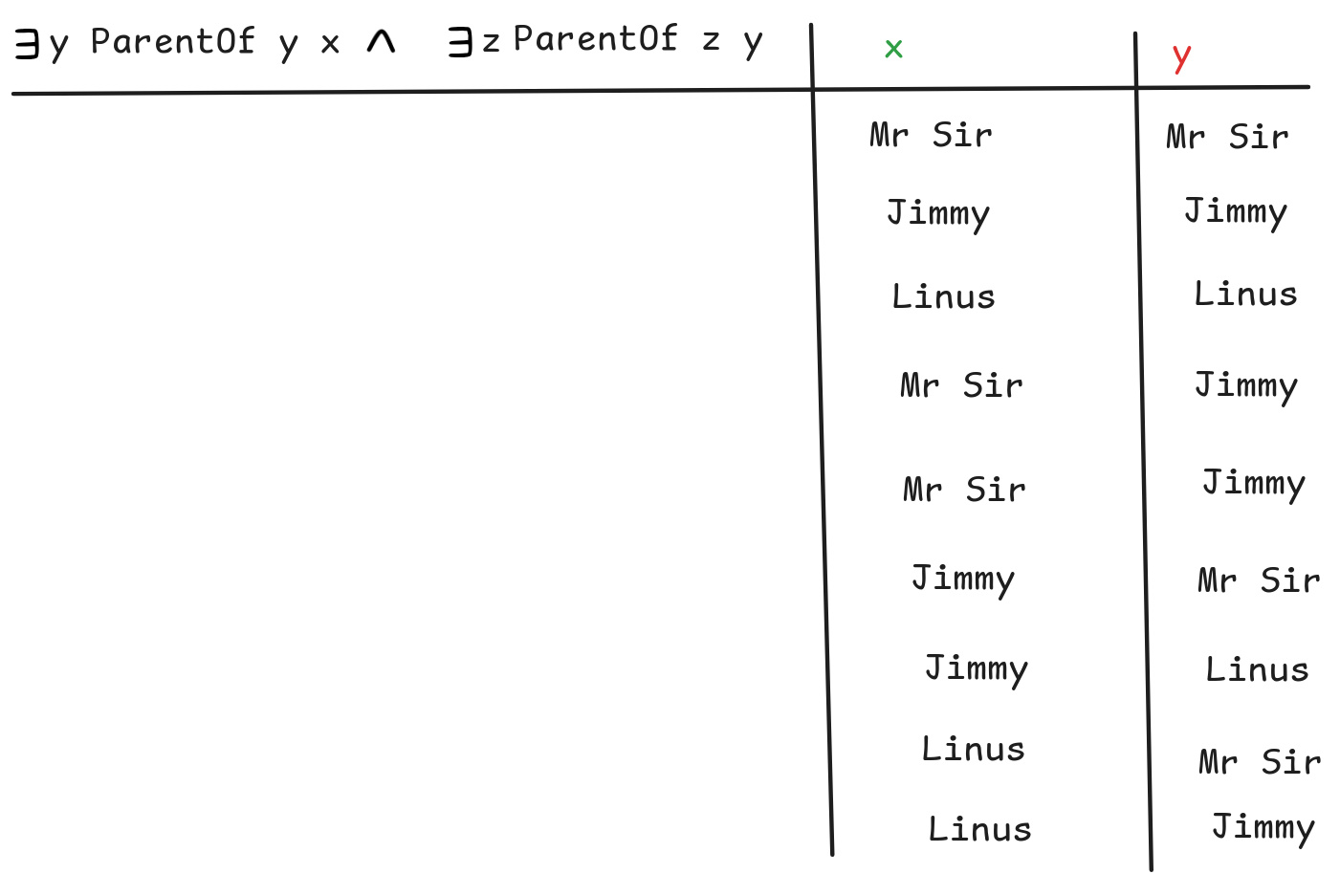Tutorial 8. FOL
Exercise sheet
Decoding FOL
Paraphrase the following FOL formulas in natural language:
-
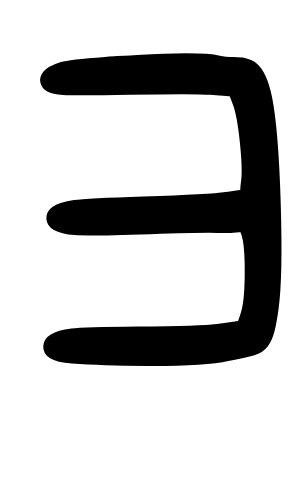 x (FatherOf x brotherOf jimmy
x (FatherOf x brotherOf jimmy

 FatherOf x jimmy)
FatherOf x jimmy) -
 x ( Fish x
x ( Fish x

 y (Fish y
y (Fish y
 BiggerThan y x ))
BiggerThan y x )) -
 x SiblingOf jimmy x
x SiblingOf jimmy x

 x( SiblingOf
jimmy x
x( SiblingOf
jimmy x

 y ( Sibling x y
y ( Sibling x y
 YoungerThan y
x))
YoungerThan y
x)) -
 x
x
 y (Thief x
y (Thief x
 Thief y
Thief y

 x = y)
x = y)
Solution
-
There is a person who’s the father of Jimmy’s brother but not Jimmy’s father.
-
For each fish, there’s a bigger fish.
-
If Jimmy has a sibling at all, then one of Jimmy’s siblings is older than all of their siblings.
-
There are at least two different thieves.
Knowledge Engineering in FOL
Knowledge engineering is the complex process of developing a framework in which to encode knowledge about a specific domain. There are different approaches to this problem, but here we’ll try out an FOL-based approach.
The problem we’re tackling is to represent information about a given setup using FOL formulas. The first step on the approach is to decide on a suitable vocabulary. Since we’re working with FOL languages, this means that we need to pick suitable constants, function symbols, and predicates to represent the information. Picking the right vocabulary is crucial for success when dealing with a knowledge engineering problem: choosing the wrong vocabulary can make representations clunky and hard to work with, even if—in some sense—still correct.
Picking the right language is closely related to finding a suitable
ontology
for the
problem. That is, we need to say which objects exist in the information, which
functions and properties are at play. We also need to answer questions like
whether we can reduce some properties to others do have a simpler language. For
example, should we have a separate predicate for Uncle² or should we define it
using Male¹, Sibling², and Parent², where rather than Uncle x y we use:
Male y

 z (Parent z x
z (Parent z x
 Sibling y z)
Sibling y z)
Uncle x y is much simpler, but the previous formula contains more information.
There is a trade-off that needs to be weighed carefully for every proposed
knowledge engineering solution.
The second step in FOL knowledge engineering is to take the given information and to encode it with FOL formulas. Here, the main challenge is adequacy: we need to find formulas whose FOL truth-conditions resemble the given information as closely as possible, while remaining within the confines of FOL.
For a concrete knowledge engineering problem, lets consider the following marketing information about IA provided by its developer:
 Our IA
is the top-of-the-line AI system from AI-Labs. It is
a hybrid system that has both symbolic and sub-symbolic sub-routines. This means
that IA
is both capable of carrying out all traditional
reasoning tasks, such as natural deduction or
Our IA
is the top-of-the-line AI system from AI-Labs. It is
a hybrid system that has both symbolic and sub-symbolic sub-routines. This means
that IA
is both capable of carrying out all traditional
reasoning tasks, such as natural deduction or SAT solving, as well as
different learned tasks, such as image and voice recognition. This is in
contrast to its predecessor model KnowIt∀, which only had symbolic routines
and could only carry out reasoning tasks. It also makes IA
superior to
the competition’s model, DeepL, which is a purely sub-symbolic AI-system and
while able to carry out all learned tasks, can only carry out some simple
reasoning tasks.
-
Devise a suitable FOL language for encoding the information about the three AI-systems. Justify your design choices.
-
Encode as much information as possible from the advert as FOL formulas. Is there information you chose not to include? If so, why?
-
It’s a bad idea to include a function symbol
makerOfin this language. Explain why.
Solution
-
There are different ways of doing this. One way to go is this:
-
Constants:
∀I,KnowIt∀,DeepL,image_recognition,voice_recognition,natural_deduction,sat_solving -
Predicates:
IsSymbolic²,IsSubSymbolic²,IsReasoningTask¹,IsLearnedTask¹,IsCapableOf²
This language has names for certain tasks, like voice recognition or natural deduction, which means that it includes them in its ontology. This means, for example, that in models of that language these tasks will be objects in the domain. An alternative approach would be to include corresponding properties, like
IsCapableOfNaturalDeduction¹, which however leads to a proliferation of predicates. -
-
At a minimum, the following information should be included:
IsSymbolic ∀I IsSubSymbolic ∀I
IsSubSymbolic ∀I x (IsReasoningTask x
x (IsReasoningTask x
 IsCapableOf ∀I x)
IsCapableOf ∀I x) x (IsLearnedTask x
x (IsLearnedTask x
 IsCapableOf ∀I x)
IsCapableOf ∀I x)IsCapableOf ∀I natural_deduction,IsCapableOf ∀I sat_solvingIsCapableOf ∀I voice_recognition,IsCapableOf ∀I image_recognitionIsSymbolic KnowIt∀
 IsSubSymbolic KnowIt∀
IsSubSymbolic KnowIt∀ x (IsCabaleOf KnowIt∀ x
x (IsCabaleOf KnowIt∀ x
 IsReasoningTask x)
IsReasoningTask x) IsSymbolic DeepL
IsSymbolic DeepL
 IsSubSymbolic DeepL
IsSubSymbolic DeepL x (IsLearnedTask x
x (IsLearnedTask x
 IsCapableOf ∀I x)
IsCapableOf ∀I x) x (IsReasoningTask x
x (IsReasoningTask x
 IsCapableOf ∀I x)
IsCapableOf ∀I x)
Implied but not explicitly stated is:
 x (IsReasoningTask x
x (IsReasoningTask x

 IsCapableOf ∀I x)
IsCapableOf ∀I x) -
We might add a constant
ai_labsand a predicateIsMakerOf²to the language to say that:IsMakerOf ai_labs ∀I
The alternative of adding a function symbol
makerOfand writingmakerOf ∀I = ai_labsis a bad idea since then we’d have to account for the meaning of terms likemakerOf ai_labs, which have unclear meaning.
Knowledge Representation with FOL Models
For this exercise, we are working with an FOL language with the following vocabulary:
-
Constants:
jimmy,linus,sir,sir,lady,gran,ny,london,soccer -
Predicates:
Loves²,IsFrom²,ParentOf²,LivesIn²
Now consider the following facts about our protagonist, little Jimmy:
Little Jimmy and his brother, Linus, are the children of Mr Sir and Lady Dame. They family lives in New York, where Lady Dame is from. But both Jimmy and his brother were born in London, where their father is from. The children’s paternal grandmother is Granny Smith, who still lives in London, where she was born. The children and their grandmother love soccer, unlike their parents.
-
Represent the information as a FOL model. Specify the model in set-theoretic terms, as a knowledge graph, and in table form. Make sure to include the information about which constant denotes which object.
-
Go to https://www.db-fiddle.com/ and, taking the code from the textbook as a template, create a SQL database that contains the information about the model. Make sure to select
SQLite v3.46on the top left for the language, otherwise the code won’t run. Verify your code by running a query that prints all tables. -
In logic, there is the concept of a diagram , which is, essentially, the idea of collecting all the true atomic sentences and true negations of atomic sentences in the model. The positive diagram is the set of only the true atomic sentences, without the true negated ones. Determine the positive diagram of the model we’ve just described. Is this essentially different from any of the other methods of representing the model?
Solution
-
Here are three representations of the model:

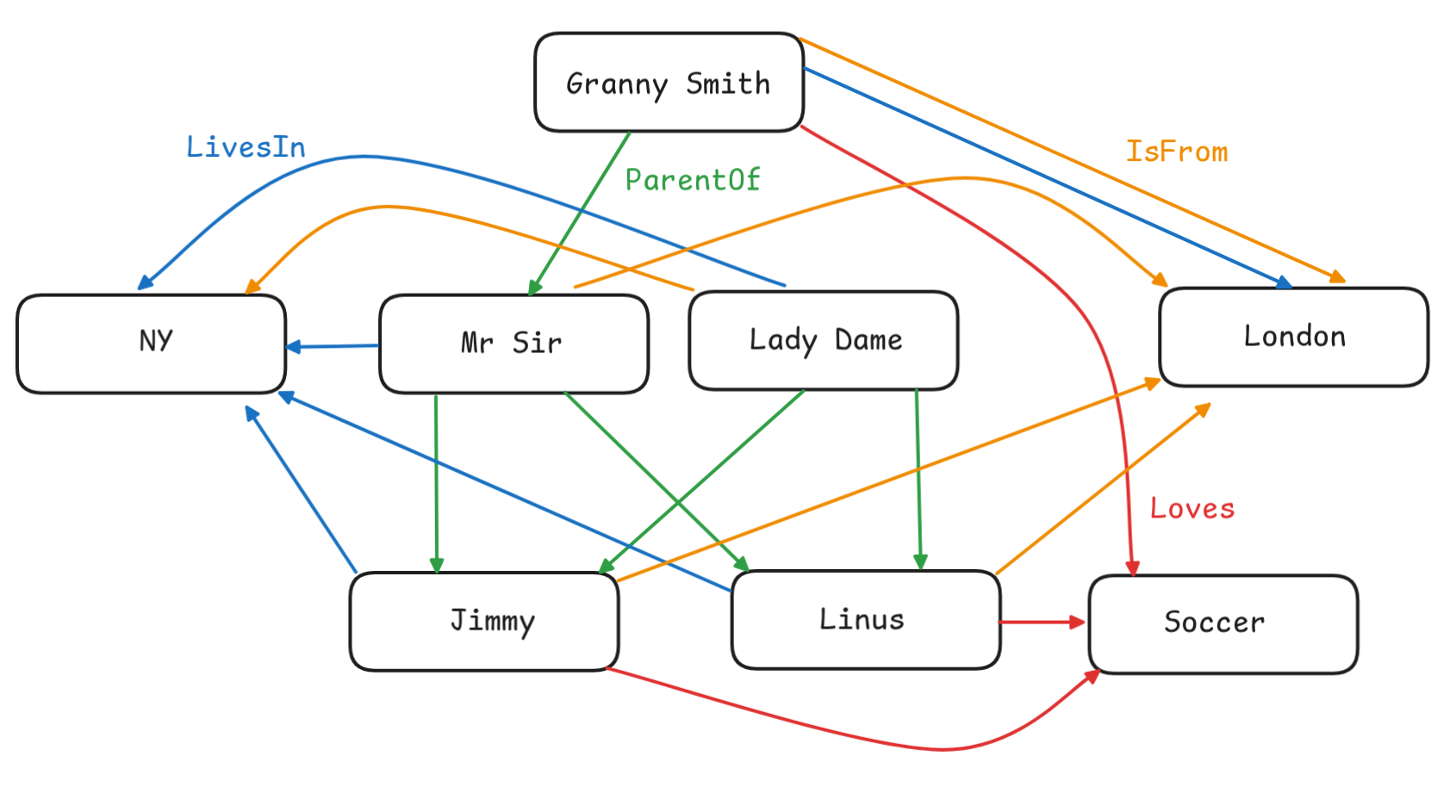
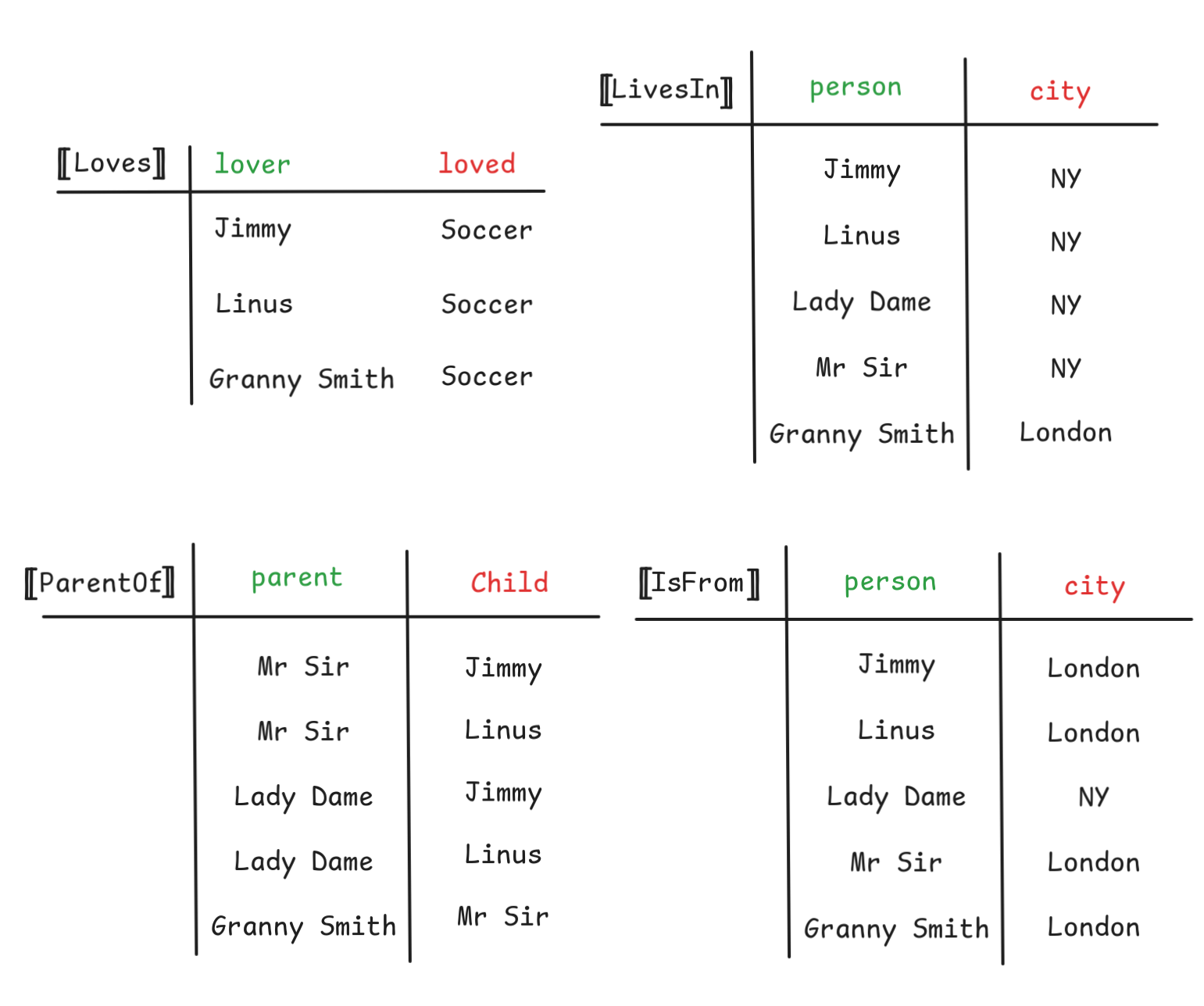
-
Here’s a db-fiddle with the corresponding tables.
-
It’s not really different from any of the previous methods. Here’s what we get:
Loves jimmy soccerLoves linus soccerLoves gran soccerIsFrom jimmy londonIsFrom linus londonIsFrom sir londonIsFrom lady nyIsFrom gran londonLivesIn jimmy nyLivesIn linus nyLivesIn sr nyLivesIn lady nyLivesIn gran londonParentOf sir jimmyParentOf sir linusParentOf lady jimmyParentOf lady linusParentOf gran sir
The full atomic diagram, however, is much larger, since there are plenty of false atoms, like
ParentOf soccer ny, so their negations are all true, including ParentOf soccer ny
ParentOf soccer ny
Denotation
Suppose that we’re working with an FOL language that has the single constant
null, as well as the function symbols succ¹ and prod².
Consider the model whose domain D = { 0, 1, 2, … } is the set of natural numbers and where:
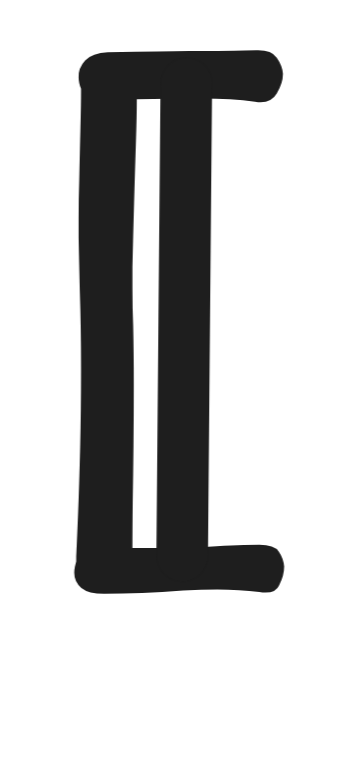 null
null
 = 0
= 0 succ
succ

 succ
succ
 (n) = n + 1
(n) = n + 1n. { 0 , 1, 2, … }
{ 0 , 1, 2, … } prod
prod

 prod
prod
 (n,m) = n × m
(n,m) = n × mn, m. { 0 , 1, 2, … }
{ 0 , 1, 2, … }
In this model, determine:
 prod succ null prod succ succ null succ null
prod succ null prod succ succ null succ null

For this purpose:
-
Parse the expression according to the grammar for FOL terms.
-
Recursively calculate the values of each term, following the terms parsing tree.
Solution
-
Here’s the parse tree:
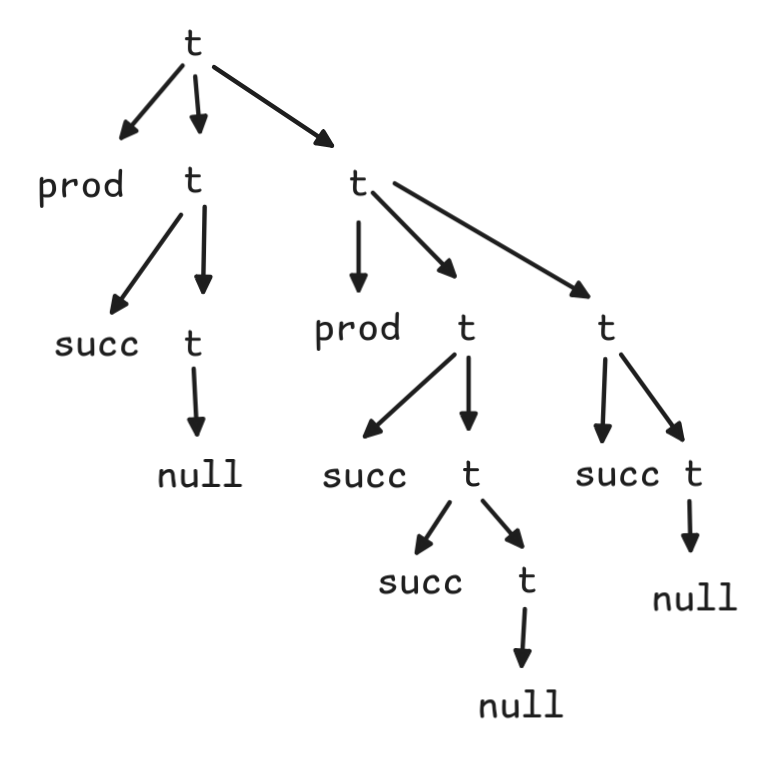
-
Here’s the calculation:
-
 null
null
 = 0
= 0 -
 suc null
suc null
 =
=
 suc
suc
 (
(
 null
null
 ) = 0 + 1 = 1
) = 0 + 1 = 1 -
 succ suc null
succ suc null
 =
=
 suc
suc
 (
(
 succ null
succ null
 ) = 1 + 1 = 2
) = 1 + 1 = 2 -
 prod succ suc null succ null
prod succ suc null succ null
 =
=
 prod
prod
 (
(
 succ succ null
succ succ null
 ,
,
 succ null
succ null
 ) = 2 x 1 = 2
) = 2 x 1 = 2 -
 prod succ null prod succ suc null succ null
prod succ null prod succ suc null succ null
 =
=
 prod
prod
 (
(
 succ null
succ null
 ,
,
 prod succ suc null succ null
prod succ suc null succ null
 ) = 1 x 2 = 2
) = 1 x 2 = 2
-
Satisfaction
In the model you’ve characterized in exercise 3, determine the extensions of the following open formulas. Give them in table form:
-
Loves x soccer IsFrom x ny
IsFrom x ny -
IsFrom x y ParentOf x sir
ParentOf x sir -
 y ParentOf y x
y ParentOf y x

 z ParentOf z y
z ParentOf z y -
IsFrom x y LivesIn x y
LivesIn x y
Solution
SQL Queries
We’ve mentioned that there is a one-to-one correspondence between SQL queries. In this exercise, we’ll explore this connection a bit more.
We return to our country DB from the textbook. You can open it again under db-fiddle .
I should preface this that what we’re doing here is not great SQL practice. We’re writing code that might seem unnatural in SQL and there certainly are better ways to code the queries. The point here is to get the idea of the correspondence across and then worry about learning to code “clean” SQL later (if you want to).
So: SQL is a rich and powerful language of domain-specific languages, and there are much easier ways to make some of these queries.
With this disclaimer out of the way, the starting point for our discussion of the relation between DB queries and open FOL formulas was the observation the SQL query

|
|
directly corresponds to the open formula:
LocatedIn x Europe
This correspondence consists in the fact that the table returned by the query is precisely the extension of the formula. To begin with, let’s see if you can formula queries that correspond to other atoms:
-
Write SQL queries that correspond to to the following atomic open formulas:
LanguageOf UnitedStates xLocatedIn Japan xLocatedIn x x
Verify your results using the df-fiddle.
We form complex formulas using the logical operators. These syntactic operations are mirrored by operations on the queries.
Let’s talk about the negation operator
 first. To negate our atomic
query for
first. To negate our atomic
query for LocatedIn(x,Europe), we’d use the WHERE
NOT EXISTS sub-query, such that

|
|
becomes

|
|
So, the idea is that we can look for the countries from the CapitalOf table,
for which the query corresponding to our unnegated query doesn’t return any
value. Note that this assumes that all countries occur in the CapitalOf and
in the LocatedIn table. If that’s not the case, we’d need a domain table, but
that’s another story.
To test the understanding of this:
-
Write SQL queries that correspond to to the following negations:
 LanguageOf UnitedStates x
LanguageOf UnitedStates x LocatedIn Japan x
LocatedIn Japan x LocatedIn x x
LocatedIn x x
To conclude our little journey into queries as FOL formulas, let’s talk about conjunction. One approach to form the conjunction is to make sub-queries for each conjunct as follows:

|
|
The only thing to watch out for here is that we need to coordinate the variables
across the sub-queries. This is what the FROM
CapitalOf AS c and later c.country syntax does. Let’s see if you can apply
this:
-
Write SQL queries that correspond to to the following conjunctions:
LocatedIn x Europe
 LanguageOf x Dutch
LanguageOf x Dutch LocatedIn Japan x
LocatedIn Japan x

 CaptailOf x WashingtonDC
CaptailOf x WashingtonDC
We can go on from here and cover disjunction, conditionals, and existentials, but I hope that the sub-pattern strategy pattern has become clear. This is one way to obtain SQL queries for ever FOL formula. There is much more to be said about this, but let’s leave it here.
As a final brain teaser:
- Write SQL queries that corresponds to
LocatedIn x Europeusing only the patterns for LanguageOf x English
LanguageOf x English and
and
 we’ve already discussed.
we’ve already discussed.
Solution
-
Here’s a list of queries that work:
-
LanguageOf UnitedStates x
1 2 3SELECT language FROM LanguageOf WHERE country = 'United States'; -
LocatedIn Japan x
1 2 3SELECT continent FROM LocatedIn WHERE country = 'Japan'; -
LocatedIn x x
1 2 3SELECT country, continent FROM LocatedIn WHERE country = continent;
-
-
Here we go:
-
 LanguageOf UnitedStates x
LanguageOf UnitedStates x
1 2 3 4 5 6 7 8SELECT language FROM Language WHERE NOT EXISTS ( SELECT * FROM Language WHERE country = 'United States' AND Language.language = language ); -
 LocatedIn Japan x
LocatedIn Japan x
1 2 3 4 5 6 7 8SELECT DISTINCT continent FROM LocatedIn WHERE NOT EXISTS ( SELECT * FROM LocatedIn WHERE country = 'Japan' AND LocatedIn.continent = continent ); -
 LocatedIn x x
LocatedIn x x
1 2 3 4 5 6 7 8SELECT continent FROM LocatedIn WHERE NOT EXISTS ( SELECT * FROM LocatedIn WHERE country = 'Japan' AND LocatedIn.continent = continent );
-
-
And the last
-
LocatedIn x Europe
 LanguageOf x Dutch
LanguageOf x Dutch
1 2 3 4 5 6 7 8 9 10 11 12 13 14 15 16 17SELECT country FROM CapitalOf AS outer WHERE -- LocatedIn(x, 'Europe') EXISTS ( SELECT * FROM LocatedIn WHERE country = outer.country AND continent = 'Europe' ) -- ¬Language(x, 'Dutch') AND NOT EXISTS ( SELECT * FROM LanguageOf WHERE country = outer.country AND language = 'Dutch' ); -
 LocatedIn Japan x
LocatedIn Japan x

 CaptailOf x WashingtonDC
CaptailOf x WashingtonDC
1 2 3 4 5 6 7 8 9 10 11 12 13 14 15 16 17SELECT country FROM CapitalOf AS outer WHERE -- ¬ LocatedIn Japan x NOT EXISTS ( SELECT * FROM LocatedIn WHERE country = 'Japan' AND continent = outer.country ) -- ¬CapitalOf x Washington D.C. AND NOT EXISTS ( SELECT * FROM CapitalOf WHERE country = outer.country AND capital = 'Washington D.C.' );
-
-
Here we go:

|
|
A much simpler code uses OR, but that wasn’t the
question:

|
|


